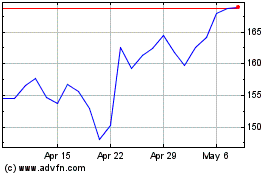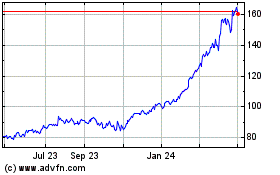P&G Overhauls Bonus System for Managers
June 30 2016 - 5:00PM
Dow Jones News
Procter & Gamble Co. is overhauling its incentive system for
managers as part of an effort by Chief Executive David Taylor to
cut through the company's bureaucratic morass and jump-start sales
growth.
Starting Friday, annual bonuses for thousands of senior managers
will be tied more directly to the performance of each leader's
specific business unit instead of being based on the company's
broader, regional operations.
"We are trying to get a clearer line of sight between an
individual's responsibilities and their results and their
compensation," Chief Financial Officer Jon Moeller said this week
in an interview. Annual bonuses account for less than 10% of a
lower-level manager's pay, while the senior executives may receive
more in bonus pay than salary.
P&G executives have acknowledged recently that the maker of
Pampers diapers and Tide detergent has been too slow to respond to
changing trends, from a shift toward premium products in China to
the phenomenon of subscription services for consumer staples such
as razors.
The company's annual sales growth has sputtered since the
recession, hitting a four-year low of $70.7 billion in 2015. The
company has cut more than 20,000 jobs since 2012 and sold off more
than $20 billion in brands it considered outside its core
focus.
Mr. Taylor, who took over in November, and his lieutenants see
the company's sprawling corporate structure and lack of
accountability as a hurdle to change.
Under the P&G's old reward system, annual bonuses were doled
out to managers based on how well P&G performed overall in
their region. For instance, those in charge of laundry-detergent
sales in the U.S. would receive bonuses if P&G performed well
in the U.S. overall, even if detergent sales fared poorly.
"Now, they will get paid based on U.S. laundry-detergent
results," Mr. Moeller said.
Incentive changes are part of a broader effort to change
P&G's culture. The company also aims to move away from a
strictly promote-from-within mentality and is working to keep the
most experienced workers jobs where they have expertise rather then
shifting them around the company.
"This is simply one brick in the foundation as we change our
culture to drive the leadership behaviors we need to win," a
P&G spokesman said.
In making the change, P&G is tackling a conundrum faced by
many multinational companies: whether to emphasize the performance
of individual business units, regional divisions or the larger
company.
"It's a very fine balance," said Raffaella Sadun, a Harvard
Business School assistant professor of strategy. "Incentives should
reflect individual performance of the unit, but the subunits are
part of the larger unit. How do you reward autonomy without
jeopardizing the performance and the synergies of the larger
business."
P&G is the latest corporate heavyweight to rethink
entrenched employee reward programs. General Electric Co. and
Goldman Sachs Group Inc. are among the companies looking to
re-engineer how they evaluate and pay employees.
GE in recent years has made a number of tweaks to its
compensation in an effort to better align incentives with outcomes,
and to incentivize employees to work in teams. The company has been
considering doing away with staples such as the annual raise and a
five-category rating system for employees. Goldman Sachs recently
said it would no longer rate staff on a scale of one to nine, and
would provide more frequent feedback, though bonuses will still be
tied to annual performance reviews.
At P&G, regional units have been getting more autonomy in
deciding how to bring their products to market, from determining
pricing to working with retailers on how goods will be arranged on
store shelves, Mr. Moeller said. Major decisions around allocation
of research-and-development funds and budget allocation will
continue to be made by executives with global purview.
Sundar Raman, P&G's marketing director of fabric care in
North America, said having more say over U.S. retail strategy
helped P&G wean some big chains off profit-eroding
buy-one-get-one-free deals.
Mr. Raman said he was able to use his new authority to set
pricing locally to get retailers to agree to other types of
promotions that would help them sell more laundry products without
big giveaways.
"That was something that cannot be done by scale or by working
across geographies," he said. "It's very specific to the Wal-Marts
and the Targets and the Dollar Generals in the United States."
Write to Sharon Terlep at sharon.terlep@wsj.com
(END) Dow Jones Newswires
June 30, 2016 16:45 ET (20:45 GMT)
Copyright (c) 2016 Dow Jones & Company, Inc.
GE Aerospace (NYSE:GE)
Historical Stock Chart
From Mar 2024 to Apr 2024

GE Aerospace (NYSE:GE)
Historical Stock Chart
From Apr 2023 to Apr 2024
